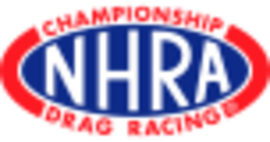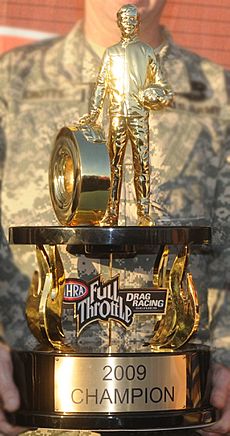National Hot Rod Association facts for kids
 |
|
| Sport | Drag racing |
|---|---|
| Jurisdiction | North America |
| Abbreviation | NHRA |
| Founded | May 1951 |
| Headquarters | San Dimas, California Brownsburg, Indiana, U.S. |
| President | Glen Cromwell |
| Chairman | Dallas Gardner |
| Official website | |
The National Hot Rod Association (NHRA) is a group that makes the rules for drag racing. They also host exciting races across the United States and Canada. With over 40,000 drivers, the NHRA says it's the biggest motorsport organization in the world.
Wally Parks started the association in 1951 in California. His goal was to create a group that would organize and promote drag racing safely. The first big NHRA race happened in 1955 in Great Bend, Kansas. Today, the NHRA Mission Foods Drag Racing Series is their main event series. It has 24 races each year and brings together the best drag racers from all over. The NHRA U.S. Nationals are now held at Lucas Oil Raceway in Brownsburg, Indiana. Winners of these national events get a special trophy called "The Wally", named after founder Wally Parks.
Contents
History of NHRA Drag Racing
Wally Parks, who was also an editor for Hot Rod magazine, started the NHRA. He wanted to encourage "safety, good sportsmanship, and friendship" among people who loved hot rods. In its first year, the group gained about 25,000 members. Within six years, it had grown to over 57,000 members!
Hot Rod magazine and the NHRA worked together to show everyone, especially the police, that hot-rodders were different from reckless street racers. They encouraged adults, like auto shop teachers, to get involved. The NHRA even made short films to improve the image of hot-rodders. One film, The Cool Hot Rod (1953), showed a teen learning that a "reckless kid in an old junker is not a hot-rodder at all."
In 1954, the NHRA started the "Drag Safari." This was a tour across the country to promote organized and safe drag racing. The Safari team met with police and city officials in each town. They explained their program, involved local car clubs, and set up drag races. This Drag Safari helped lead to the first US Nationals in 1955.
Due to the coronavirus pandemic in the United States, the NHRA had to cancel its 2020 and 2021 races at the Virginia Motorsports Park. Regular racing started again in 2022.
Today, the NHRA has two main offices. One is in San Dimas, California, and the other is in Brownsburg, Indiana. The offices for the Mission Foods Drag Racing Series are in Brownsburg.
NHRA Racing Series
Top Professional Classes
The NHRA Mission Foods Drag Racing Series is the highest level of racing in the NHRA. It features four exciting professional classes:
- Top Fuel Dragster
- Funny Car
- Pro Stock
- Pro Stock Motorcycle
You can find a full list of champions for these classes here: List of NHRA champions.
NHRA Sportsman Racing Series
Besides the professional classes, there are many "Sportsman Classes." These classes are for a wider range of racers. They include categories like Snowmobile, Motorcycle, Super Street, Super Gas, Stock Eliminator, and more.
While the NHRA promotes the professional classes at national events, most of its participants are Sportsman Racers. These racers must be members of the NHRA to compete in any event.
The Sportsman series also includes the Lucas Oil Drag Racing Series, the Summit Racing Equipment Racing Series, and the NHRA Jr. Drag Racing League. The Jr. Drag Racing League is for younger racers!
The Sportsman Drag Racing Series used to have seven divisions across the country. Since 2012, the Top Alcohol Dragster and Top Alcohol Funny Car classes race in four regions: East, North Central, Central, and West.
Sportsman Champions with Multiple Wins
Many talented Sportsman racers have won multiple championships. Here are some of them:
- Top Alcohol Dragster (TAD)
- 5 wins: Rick Santos (last win 2001), Bill Reichert (last win 2010), Joey Severance (last win 2022)
- 4 wins: Blaine Johnson (last win 1993)
- 3 wins: Bill Walsh (last win 1986)
- 2 wins: Jim Whiteley (last win 2013), Megan Meyer (last win 2020)
- Alcohol Funny Car (AFC)
- 17 wins: Frank Manzo (last win 2013)
- 4 wins: Pat Austin (last win 1991)
- 3 wins: Brad Anderson (last win 1989), Sean Bellemeur (last win 2021), Doug Gordon (last win 2023)
- 2 wins: Randy Anderson (last win 1994), Bob Newberry (last win 2005), Jonnie Lindberg (last win 2016)
- Competition Eliminator (CE)
- 3 wins: Bill Maropulos (last win 1987), David Rampy (last win 2017), Frank Aragona Jr. (last win 2019), Bruno Massel (last win 2021)
- 2 wins: Coleman Roddy (last win 1984), Andy Manna, Jr (last win 1999), Dean Carter (last win 2004)
- Super Stock (SS)
- 5 wins: Peter Biondo (last win 2014)
- 4 wins: Jimmy DeFrank (last win 2012), Greg Stanfield (last win 2021)
- 3 wins: Justin Lamb (last win 2018)
- 2 wins: Keith Lynch (last win 1983), Jim Boburka (last win 1989), Jeff Taylor (last win 1991), Dan Fletcher (last win 2001)
- Stock
- 4 wins: Kevin Helms (last win 2015)
- 2 wins: Jim Hughes (last win 1989), Al Corda (last win 1997), Lee Zane (last win 2008), Edmond Richardson (last win 2009), Brad Burton (last win 2012), Justin Lamb (last win 2017)
National Records for Speed
Here are some of the fastest times recorded in different NHRA classes:
| Class | Date | Track | Driver | Elapsed Time (seconds) |
|---|---|---|---|---|
| Top Fuel | September 13, 2019 | Maple Grove Raceway | Brittany Force | 3.623 |
| Funny Car | August 18, 2017 | Brainerd International Raceway | Robert Hight | 3.793 |
| Pro Stock | March 14, 2022 | Gainesville Raceway | Erica Enders | 6.450 |
| Pro Stock Motorcycle | October 14, 2023 | Texas Motorplex | Gaige Herrera | 6.627 |
| Pro Modified | March 14, 2021 | Gainesville Raceway | Jose Gonzalez | 5.621 |
| Top Alcohol Dragster | September 6, 2020 | Indianapolis Raceway Park | Megan Meyer | 5.090 |
| Top Alcohol Funny Car | March 17, 2019 | Gainesville Raceway | Sean Bellemeur | 5.352 |
NOTE: Top Fuel and Funny Car records are measured over 1,000 feet (304.8 meters).
NHRA Race Tracks
The NHRA has over 100 member tracks across the United States. They currently lease and operate three tracks: In N Out Pomona Dragstrip, Gainesville Raceway, and Lucas Oil Raceway. They used to own National Trail Raceway and Atlanta Dragway.
Safety in Drag Racing
The NHRA has many rules and special equipment to keep drivers safe during races.
- Safety Harness: All cars must have a five-point safety harness. This keeps the driver secure and can be released quickly in an emergency.
- Fire Suits: Drivers in the fastest classes wear special fire suits. These suits have seven layers of Nomex fabric to resist fire. They also include Nomex gloves, socks, and head coverings.
- Fuel Cells: Non-nitromethane cars use a special bladder in their fuel tanks. This helps prevent fuel leaks and explosions.
- HANS Device: This device limits head and neck movement during a crash.
- Titanium Shield: Dragsters and Funny Cars have a titanium shield behind the driver's head. This protects them from flying debris.
- Fire Extinguishing System: Cars have on-board fire systems that spray the engine if it catches fire. Drivers can also activate it manually.
- Roof Escape Hatch: Funny Cars have a hatch on the roof. This allows drivers to escape safely during an engine fire.
- Wheelie Bars: Long bars at the back of the cars, called "wheelie bars," stop the car from flipping over when it starts.
- Engine Diapers: "Diapers" under the engine catch liquids and broken parts if the engine breaks down. This keeps the track clean and safe.
- Tire Safety: The rear tires, called "slicks," are made from a very hard material. This makes them resistant to breaking apart. They must also be inflated to at least 7 psi (48 kPa).
- Braking Parachutes: Cars that can go over 150 miles per hour need parachutes to help them stop.
- Engine Blankets: Cars going 9.99 seconds or quicker in the quarter-mile must have a fireproof blanket around the engine. This helps contain debris if the engine explodes.
- Roll Bar Padding: After a serious accident in 2007, Funny Car roll bars were improved. They are now padded and covered with Nomex to prevent fires.
- Sand Traps: At the end of the track, there's a long, deep sand pit. This "sand trap" helps slow down or stop cars that can't brake normally. These traps were made longer and deeper after a crash in 2008.
- Padded Walls: Heavily padded walls are now at the end of the sand traps. These walls can withstand high-speed impacts.
- Automatic Shutoff Sensor: Since 2009, Funny Cars and Top Fuel cars have a sensor. If the engine backfires or explodes, it automatically shuts off the fuel pump and deploys the parachutes.
- Track Length: For nitromethane-powered cars (Funny Cars and Top Fuel), the race distance was shortened to 1,000 feet (305 meters). This helps reduce the risk of explosions at very high speeds. Other classes still race the full 1,320-foot quarter-mile (402 meters).
- Automatic Shutdown System: Since 2010, Top Fuel cars have a system that automatically shuts off the engine and deploys parachutes if the driver can't do it. This happens if the car passes special transmitters on the track.
- Fan Safety: Fans are no longer allowed within 75 feet (23 meters) of the guardrail. This rule was put in place after some accidents where spectators were injured.
- Frame Strength: Rules now prevent the use of certain hard steel in the frames of Top Fuel and Funny Cars. This change came after a crash where a car's frame broke apart.
The Safety Safari
The NHRA has a special team of safety personnel called the Safety Safari. Their job is to handle fires, clean up the track after accidents, and help drivers until medical teams arrive. The Safety Safari has been around since the late 1960s. Their work has greatly reduced serious injuries. There are also EMTs and air medical services at every event.
The original "Drag Safari" started its tour in 1954. It included four original members: Bud Coons, Bud Evans, Eric Rickman, and Chic Cannon.
Safety Incidents and Improvements
Even with many safety rules, accidents can still happen. Here are some notable incidents that led to important safety improvements:
| Name | Location | Year |
|---|---|---|
| "Sneaky" Pete Robinson | Auto Club Raceway at Pomona | 1971 |
| John Hagen | Brainerd International Raceway | 1983 |
| Blaine Johnson | Indianapolis Raceway Park | 1996 |
| Elmer Trett | Indianapolis Raceway Park | 1996 |
| Darrell Russell | Gateway International Raceway | 2004 |
| Eric Medlen | Gainesville Raceway | 2007 |
| Scott Kalitta | Englishtown, NJ | 2008 |
| Neal Parker | Englishtown, NJ | 2010 |
| Mark Niver | Pacific Raceways | 2010 |
More About Drag Racing
- Wally Parks NHRA Motorsports Museum
- International Hot Rod Association
- National Electric Drag Racing Association
- United States Hot Rod Association
- Santa Ana Drags
- Pro Street
See also
 In Spanish: National Hot Rod Association para niños
In Spanish: National Hot Rod Association para niños


